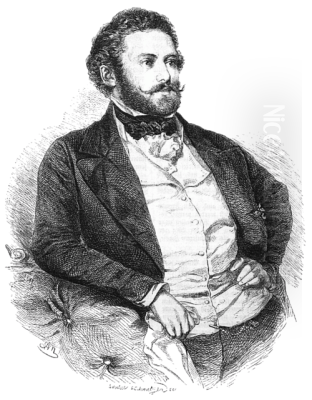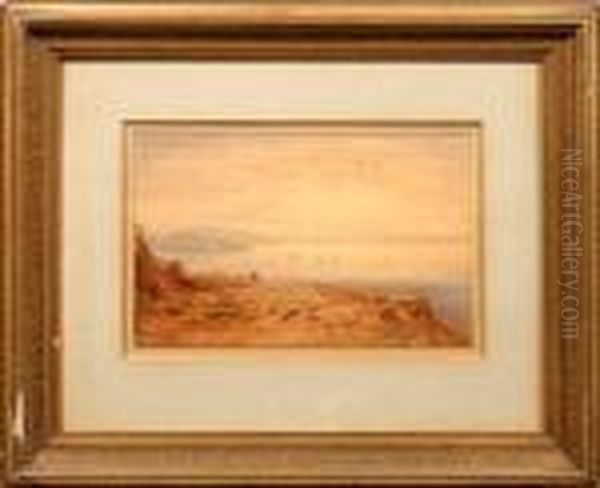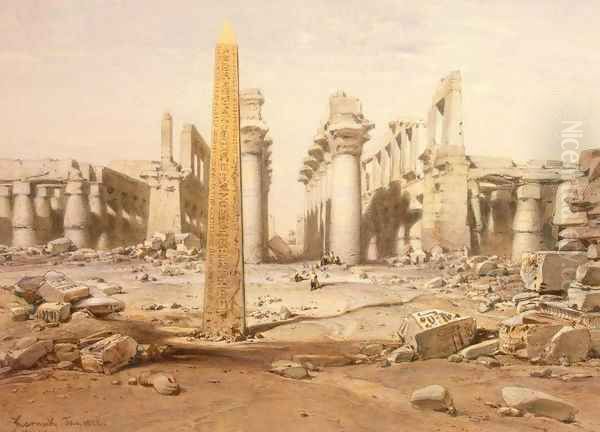
Eduard Hildebrandt stands as a significant figure in 19th-century German art, renowned primarily for his extensive travels and the luminous landscape and genre paintings that resulted from them. Born into an era of burgeoning global exploration and romantic fascination with the exotic, Hildebrandt capitalized on these themes, creating a vast body of work, particularly in watercolor, that captured the light, atmosphere, and unique character of diverse locations across the globe. His art bridges the detailed observation associated with Realism and the evocative moodiness of Romanticism, making him a distinctive voice in the landscape painting tradition of his time.
Early Life and Artistic Beginnings in Prussia
Eduard Hildebrandt was born on January 9, 1818, in the port city of Danzig (modern-day Gdańsk, Poland), which was then part of the Kingdom of Prussia. His early life in a bustling maritime center may have instilled in him a sense of wanderlust that would later define his career. Seeking formal artistic training, he moved to Berlin, the Prussian capital and a major hub for arts and culture.
His initial foray into the established art world was met with a setback. According to anecdotes, Hildebrandt sought admission to the prestigious Berlin Academy of Arts but was reportedly rejected due to a perceived "lack of talent." Undeterred by this early obstacle, he demonstrated resilience and determination. He pursued his artistic education independently, seeking private instruction.
A crucial step in his development was studying under Wilhelm Krause, a recognized marine painter based in Berlin. Krause's expertise in depicting seascapes and coastal scenes likely provided Hildebrandt with foundational skills in capturing water, sky, and atmospheric effects – elements that would become central to his later work. This period in Berlin laid the groundwork for his technical proficiency and solidified his commitment to landscape and marine subjects.
Parisian Studies and the Influence of Isabey
Seeking to broaden his artistic horizons and refine his technique, Hildebrandt traveled to Paris around 1842. The French capital was then a vibrant center of artistic innovation, particularly in landscape painting. There, he entered the studio of Eugène Isabey, a highly respected French painter known for his dramatic seascapes, historical genre scenes, and mastery of watercolor.

Studying with Isabey proved transformative for Hildebrandt. Isabey, associated with the Romantic movement and having connections to the emerging Barbizon School painters like Théodore Rousseau and Narcisse Virgilio Díaz de la Peña, emphasized capturing fleeting effects of light and atmosphere, often with a fluid, expressive touch. Hildebrandt absorbed these influences, particularly honing his skills in watercolor, a medium favored by Isabey for its immediacy and luminosity. He learned to handle washes effectively, creating subtle gradations of tone and vibrant color effects that would become hallmarks of his style. The French "touch" and emphasis on visual effect, rather than purely topographical accuracy, added a new dimension to his Prussian training.
The Patronage of Humboldt and the Journey to Brazil
Hildebrandt's talent and ambition soon attracted influential patrons. A pivotal connection was his introduction to the renowned naturalist, explorer, and polymath Alexander von Humboldt. Humboldt, a towering figure in European intellectual life, was deeply interested in the visual representation of the natural world, particularly the landscapes of the Americas he had explored decades earlier. He saw in Hildebrandt a promising artist capable of capturing the unique character of distant lands.
Through Humboldt's advocacy, Hildebrandt gained the attention and support of King Frederick William IV of Prussia. The King, known for his interest in the arts and architecture, commissioned Hildebrandt to travel to Brazil in 1844. This journey marked the beginning of Hildebrandt's career as a global travel painter. He spent considerable time in Rio de Janeiro and its surroundings, documenting the lush tropical landscapes, the vibrant street life, and the dramatic coastal scenery.
His Brazilian watercolors and oil paintings, such as views of Rio's harbor and street scenes, were highly praised upon his return. They showcased his developing ability to render exotic locales with both accuracy and atmospheric charm, capturing the intense light and unique flora of South America. This successful expedition solidified his reputation and fueled his desire for further exploration.
Travels Across the Near East and Mediterranean
Following the success of his Brazilian venture, Hildebrandt embarked on another major journey between 1851 and 1852, this time focusing on the Mediterranean and the Near East. This region held immense fascination for European Romantics, offering landscapes steeped in history, biblical associations, and perceived exoticism. His itinerary included Egypt, Palestine, Syria, Turkey, and Greece.
He meticulously documented the ancient ruins, bustling bazaars, desert landscapes, and coastal cities he encountered. His watercolors from this period, such as views of Constantinople (Istanbul), Cairo, Jerusalem, and Athens, are among his most celebrated works. He demonstrated a keen eye for architectural detail, the play of light on ancient stones, and the daily life of the people. Works like his Jerusalem series provided Europeans with vivid impressions of the Holy Land.

These travels allowed Hildebrandt to further refine his ability to capture diverse climatic conditions and light effects – from the hazy heat of the Egyptian desert to the clear light of the Aegean Sea. He often contrasted grand historical sites with contemporary human activity, adding layers of narrative and interest to his compositions. His depictions of the Near East resonated with the contemporary European interest in Orientalism, providing visually compelling images of lands that were becoming increasingly accessible yet still seemed remote and mysterious.
Exploring Europe and Venturing North
While best known for his depictions of exotic, faraway lands, Hildebrandt also traveled extensively within Europe. Between 1853 and 1854, he journeyed through Spain, Portugal, Madeira, and the Canary Islands. These travels yielded numerous works capturing the distinctive landscapes, architecture, and coastal scenery of Iberia and the Atlantic islands. His Spanish scenes, for instance, often depicted dramatic mountain ranges, historic cities, and coastal views, rendered with his characteristic attention to light and atmosphere.
In 1856, Hildebrandt undertook a more unusual journey, venturing north towards the Arctic. He traveled to Norway and Spitsbergen (Svalbard), experiencing the stark beauty and unique light conditions of the high latitudes. This expedition demonstrated his adventurous spirit and his commitment to capturing the full spectrum of the world's diverse environments, from tropical jungles to icy fjords. His Arctic scenes, though perhaps less numerous than his works from warmer climes, added another dimension to his oeuvre, showcasing his versatility in adapting his technique to vastly different subjects.
Circumnavigation: The Grand World Tour
The culmination of Hildebrandt's career as a travel painter was his ambitious circumnavigation of the globe, undertaken between 1862 and 1864. This epic journey took him eastward from Europe, across continents and oceans. His route included Egypt (revisiting), India, Siam (Thailand), China, the Philippines, Japan, and then across the Pacific to California and Mexico, before returning to Europe.
This voyage provided an unparalleled wealth of subject matter. He painted bustling ports like Hong Kong and San Francisco, sacred sites like Benares (Varanasi) on the Ganges, tranquil Japanese gardens, and dramatic landscapes across Asia and the Americas. The sheer scale of this undertaking was remarkable for the time, and the resulting body of work offered a panoramic view of the mid-19th century world.
Upon his return, Hildebrandt created a large cycle of watercolors based on his sketches and observations from the world tour. These were exhibited to great acclaim, first in London in 1866 and later in Berlin. The collection, often displayed geographically, allowed viewers to embark on a visual journey around the world, guided by Hildebrandt's masterful hand. These watercolors cemented his international reputation as one of the foremost travel artists of his era. Selections were later published posthumously in chromolithograph form as Reise um die Erde (Voyage Around the World).
Artistic Style: Light, Color, and Atmosphere
Eduard Hildebrandt's artistic style is characterized by its synthesis of detailed observation and atmospheric romanticism. He possessed a remarkable ability to capture the specific quality of light in different parts of the world – the clear, sharp light of the Mediterranean, the humid haze of the tropics, the ethereal glow of the Arctic, or the golden light of sunrise and sunset. Light was not merely illumination in his work; it was often the central subject, defining mood and shaping form.
His mastery of watercolor was crucial to achieving these effects. He used transparent washes to build up layers of color and tone, creating luminosity and depth. His palette was often vibrant, employing rich blues, greens, yellows, and reds to convey the intensity of the scenes he witnessed. While capable of precise detail, particularly in architectural elements or topographical features, he often balanced this with looser, more suggestive brushwork, especially in skies, water, and foliage, enhancing the sense of atmosphere and movement.
Compared to some of his contemporaries, like the highly detailed architectural views of David Roberts or the more abstract and turbulent atmospheres of J.M.W. Turner, Hildebrandt struck a balance. His work retained a strong sense of place and realism, satisfying the documentary impulse of travel painting, while simultaneously imbuing his scenes with a romantic sensibility and a palpable sense of wonder. He shared with the Düsseldorf School painters, such as Andreas Achenbach and Oswald Achenbach, an interest in dramatic landscapes, but his global scope and emphasis on watercolor set him apart.
Notable Works and Recognition
Eduard Hildebrandt produced a prolific amount of work during his relatively short life. While many pieces reside in German collections, particularly in Berlin, his works are found in museums and private collections worldwide. Some of his most representative and celebrated works include:
Views of Rio de Janeiro (c. 1844): Capturing the iconic harbor, Sugarloaf Mountain, and street life.
The Golden Horn, Constantinople (c. 1851-52): Depicting the famous waterway with mosques and city life.
Street Scene in Cairo (c. 1851-52): Evoking the atmosphere of the Egyptian capital.
Benares on the Ganges (c. 1863): A key work from his world tour, showing the ghats and temples along the sacred river.
Hong Kong Harbour (c. 1863): Documenting the bustling activity of the British colonial port.
San Francisco Bay (c. 1864): Views of the rapidly growing Californian city.
The Reise um die Erde Cycle (exhibited 1866 onwards): The comprehensive collection of watercolors from his circumnavigation, considered his magnum opus.
His work was widely exhibited during his lifetime, earning him considerable fame and official recognition. He was appointed Professor at the Berlin Academy of Arts in 1855, a testament to how far he had come since his initial rejection. His paintings and watercolors were sought after by collectors, including royalty and aristocracy across Europe.
Contemporaries and Artistic Context
Hildebrandt operated within a rich artistic landscape in 19th-century Europe. His training connected him to the German tradition (Wilhelm Krause) and the French Romantic/Barbizon milieu (Eugène Isabey). His travels brought him into a sphere shared by other artists documenting the globe, such as the American painters Frederic Edwin Church and Martin Johnson Heade, who also depicted South American landscapes, albeit often with a more overtly sublime or luminist approach.
In Germany, his work can be seen alongside that of the Achenbach brothers (Andreas and Oswald), leading figures of the Düsseldorf School known for their dramatic European landscapes and seascapes. While sharing a commitment to realism and atmospheric effects, Hildebrandt's focus on global, often non-European subjects, and his extensive use of watercolor gave his work a distinct character. He was less focused on the heroic or allegorical landscapes sometimes favored by the Düsseldorf painters like Johann Wilhelm Schirmer, concentrating instead on capturing the specific visual character of diverse locations. His brother, Fritz Hildebrandt, was also active as a painter.
His relationship with Alexander von Humboldt was particularly significant, placing him at the intersection of art and scientific exploration, a key theme in the 19th century. Humboldt's holistic view of nature and his encouragement of detailed visual documentation profoundly shaped Hildebrandt's approach.
Later Years and Lasting Legacy
After returning from his world tour, Eduard Hildebrandt continued to work in Berlin, primarily producing finished studio pieces based on his travel sketches. He remained a celebrated figure in the Berlin art scene. However, his extensive travels and relentless work schedule appear to have taken a toll on his health.
Eduard Hildebrandt died in Berlin on October 25, 1868, at the relatively young age of 50. Despite his shortened career, he left behind an immense and significant body of work.
His legacy rests on several pillars. He was one of the most prolific and wide-ranging travel painters of the 19th century, providing Europeans with compelling visual records of cultures and landscapes across the globe at a time before photography became widespread. He was a consummate master of watercolor, demonstrating the medium's capacity for both detailed rendering and atmospheric expression. His ability to capture the nuances of light and climate remains remarkable.
While perhaps not a radical innovator who dramatically shifted the course of art history in the way the Impressionists soon would, Hildebrandt perfected a particular genre – the romantic-realist travel landscape. His work satisfied a deep public curiosity about the wider world and stands as a beautiful, evocative record of global exploration and artistic endeavor in the mid-19th century. His paintings and watercolors continue to be admired for their technical brilliance, atmospheric beauty, and historical significance as windows onto a world undergoing rapid change.